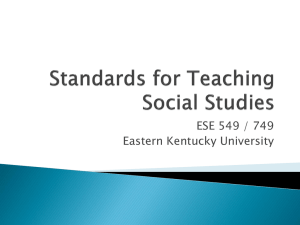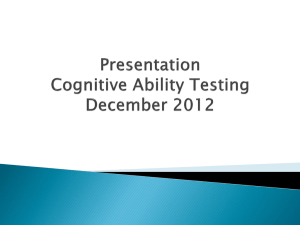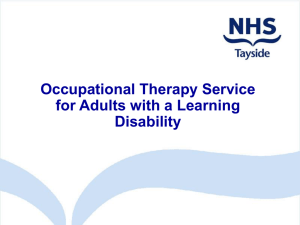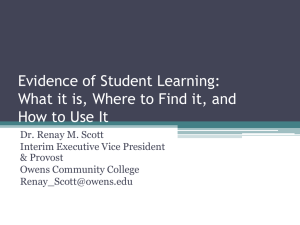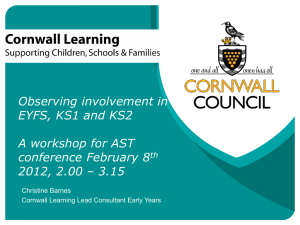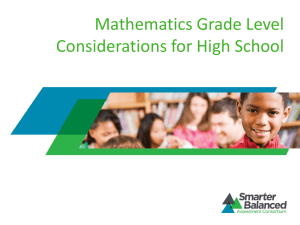TPAC - Task 2
advertisement
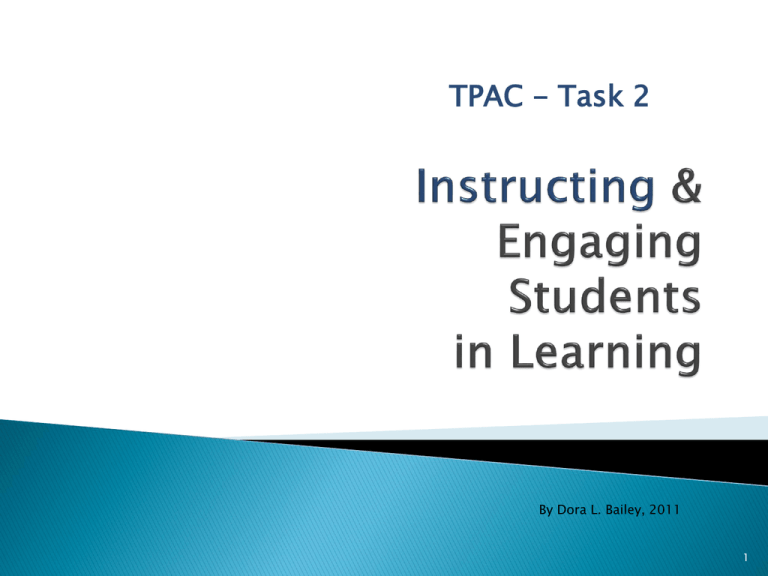
TPAC - Task 2 By Dora L. Bailey, 2011 1 Video Tape should : An analysis of the effects of teaching on students’ learning (the “so what”) 2 Assessing Video: Evidence of Teaching 1 Rank the quality of what you see 1-5: from Low level of evidence (1) to very high level of evidence (5) Task Engaging Students Learning Describe evidence students are intellectually engaged in discussions, tasks or activities, through both teacherstudent and student-student interactions, that support students to analyze or interpret accounts of an historical event or a social studies phenomenon. links made between new content and students’ prior learning and experience in ways that support interpretations of an historical event or social studies phenomenon. Deepening elicits and builds on students’ Students responses Learning to deepen understanding of how to analyze or interpret history-social studies sources and accounts or defend claims/arguments. uses conflicting or alternative evidence from various sources to challenge students to defend their claims/argument. ASCD Pre, During, Post Reading Video Series 3 Collect permission forms from parents/guardians and prepare for videorecording. ► Review and identify lessons where you are engaging your students in understanding and analyzing a significant historical event or social studies phenomenon. ► Cut to appropriate length (s) ► Respond to commentary prompts to analyze your teaching and your students’ learning in the video clips. TPAC Field Test Pre-Release Handbook Stanford University September 2011 p. 3 4 Consider how you use active, studentcentered instructional approaches to support student learning. Think about how your choices of instructional strategies engage students in evaluating sources of information, forming individual interpretations of the event or phenomenon, and defending their claims/arguments. While teaching, how do you prompt students to make connections between their prior learning and experiences and the content to be learned? 5 Clip should illustrate what you did as a teacher to help students develop their understanding of how to critically evaluate a historical or social scientific source. Sources include such things as primary source documents, artifacts, interviews, survey analysis, the textbook, a map, a documentary film, or a political cartoon. 6 Provide a copy of any relevant writing on the board, overhead, or walls if it is not clearly visible on the video. Insert this document at the end of the Instruction Commentary. For last 4 slides AYA-SS p. 10 7 Assessing: Video Evidence of Teaching 2 Embedded in TPAC Task 2: Rank what you see 1-5: from Low level of evidence (1) to very high level of evidence (5) 1 2 3 4 1 2 3 4 Engaging Students Learning students are intellectually engaged in discussions, tasks or activities, through both teacher-student and student-student interactions, that support students to analyze, interpret, problem solve, and/or experiment links made between new content and students’ prior learning and experience in ways that support interpretations , operations, usages, and/or processes meaningful content 1 2 3 4 1 2 3 4 Deepening Students Learning elicits and builds on students’ responses to deepen understanding of how to interpret, analyze, synthesizes, criticize and/or make arguments/solve problems. uses conflicting or alternative evidence from various sources to challenge students to defend/describe their position. meaningful content 1 2 3 4 1 2 3 4 Academic Language Use of academic language by teacher Use of academic language by students Use of vocabulary by teacher Use of vocabulary by students Teacher appropriately encourages students to use academic language and vocabulary meaningful content scaffolding & support for academic language development, including access to content only vs. models, practice, feedback 8 Using examples from the clips, describe how your instruction (tasks, activities, discussions, and/or teaching strategies) linked students‟ prior learning and experiences with new learning. Prior learning and experience includes students’ academic content knowledge, language development, social/emotional development, family/cultural assets, interests and lived experiences. 9 Explain how the instruction (tasks, activities, discussions, and/or teaching strategies) depicted in the clips motivated and intellectually engaged students in developing understandings of facts and concepts and in critically evaluating sources of information about the historical event or social studies phenomenon. Cite specific examples from the clips of what students said/did to support your explanation. AYA-SS, p. 11 10 -Demonstrate how you balance the teaching of skills and processes to promote language and literacy development. You will provide video evidence of your ability to intellectually engage children in meaningful learning experiences, monitor their understanding, and use your responses to children to guide their learning. -How do you prompt children to make connections between their prior learning and experiences and the identified skills and processes to be learned? Early Childhood Prompt Example 11 a) Explain how you elicited student thinking though questions or materials and facilitated responses that supported students to form interpretations, think critically, problem solve, etc. b) Cite evidence from the clips of what you and your students said/did to support your explanations. 12 a) Describe evidence in the clips that demonstrates the extent to which students are able to understand and/or use the language associated with the identified language demand (vocabulary, function/form and/or instructional language) in ways that develop students‟ understandings of facts, concepts, interpretations and analyses b) Using this evidence, how well did your language support or instruction promote academic language development for students with varied language levels? reveal students’ understanding and use of academic language associated with content learning support academic language development associated with content learning? 13 Assessing: Video Evidence of Teaching 2 Embedded in TPAC Task 2: Rank what you see 1-5: from Low level of evidence (1) to very high level of evidence (5) 1 2 3 4 1 2 3 4 Engaging Students Learning students are intellectually engaged in discussions, tasks or activities, through both teacher-student and student-student interactions, that support students to analyze, interpret, problem solve, and/or experiment links made between new content and students’ prior learning and experience in ways that support interpretations , operations, usages, and/or processes meaningful content 1 2 3 4 1 2 3 4 Deepening Students Learning elicits and builds on students’ responses to deepen understanding of how to interpret, analyze, synthesizes, criticize and/or make arguments/solve problems. uses conflicting or alternative evidence from various sources to challenge students to defend/describe their position. meaningful content 1 2 3 4 1 2 3 4 Academic Language Use of academic language by teacher Use of academic language by students Use of vocabulary by teacher Use of vocabulary by students Teacher appropriately encourages students to use academic language and vocabulary meaningful content scaffolding & support for academic language development, including access to content only vs. models, practice, feedback 14 1. If you could teach these lessons to the same group of students again, what are two or three things you would do differently to improve the learning of these students based on their varied needs and characteristics? Consider missed opportunities and other aspects of planning, instruction and/or assessment. 2. Citing evidence from your experience teaching this learning segment, explain why you would expect these changes to make a difference in student learning. 15 H4: How does the candidate actively engage students in evaluating sources of information and forming individual interpretations of the historical event or social studies phenomenon? Engaging students learning H5: How does the candidate elicit and monitor students’ responses to develop their abilities to critically evaluate accounts of an historical event or social studies phenomenon and defend their claims/arguments? Deepening students learning 16 In the clip(s), students are intellectually engaged in discussions, tasks or activities, through both teacher-student and studentstudent interactions, that support students to analyze or interpret accounts of an historical event or a social studies phenomenon. Candidate makes links between new content and students’ prior learning and experience in ways that support interpretations of an historical event or social studies phenomenon. AYA SS, p. 19 17 Candidate elicits and builds on students’ responses to deepen understanding of how to analyze or interpret history-social studies sources and accounts or defend claims/arguments. Candidate uses conflicting or alternative evidence from various sources to challenge students to defend their claims/argument. 18 Examine your plans for the learning segment and identify learning tasks in which students are actively engaged in 1) collecting and recording scientific data and/or 2) interpreting data to explain a scientific phenomenon. The clips will not include the entire inquiry process, but should provide a sample of how you interact with students to support their learning to collect and use data to construct an explanation using science concepts. 19 Cite examples of language supports seen in the clips to help your students understand the content and/or participate in scientific discourse central to the lesson. How did these strategies reflect students’ varying language proficiencies and promote their language development? 20 Describe your strategies for eliciting student thinking and how your ongoing responses further their learning. Cite examples from the clip(s). 21 Assessing: Video Evidence of Teaching 2 Embedded in TPAC Task 2: Rank what you see 1-5: from Low level of evidence (1) to very high level of evidence (5) 1 2 3 4 1 2 3 4 Engaging Students Learning students are intellectually engaged in discussions, tasks or activities, through both teacher-student and student-student interactions, that support students to analyze, interpret, problem solve, and/or experiment links made between new content and students’ prior learning and experience in ways that support interpretations , operations, usages, and/or processes meaningful content 1 2 3 4 1 2 3 4 Deepening Students Learning elicits and builds on students’ responses to deepen understanding of how to interpret, analyze, synthesizes, criticize and/or make arguments/solve problems. uses conflicting or alternative evidence from various sources to challenge students to defend/describe their position. meaningful content 1 2 3 4 1 2 3 4 Academic Language Use of academic language by teacher Use of academic language by students Use of vocabulary by teacher Use of vocabulary by students Teacher appropriately encourages students to use academic language and vocabulary meaningful content scaffolding & support for academic language development, including access to content only vs. models, practice, feedback 22 Reflect on students’ learning of concepts and academic language as featured in the video clip(s). Identify both successes and missed opportunities for monitoring all students’ learning and for building their own understanding of how to collect, analyze, and interpret data from a scientific inquiry. 23 If you could do it over, what might you have done to take advantage of missed opportunities or to improve the learning of students with diverse learning needs and characteristics? 24 Strategies for intellectual engagement seen in the clips offer structured opportunities for students to collect, analyze, and interpret scientific data. These strategies reflect attention to students’ academic or language development, social/emotional development, and/or cultural and lived experiences. 25 Candidate identifies successful and unsuccessful teaching practices. The proposed improvements are reasonable and address the learning of a subgroup or individual students. 26 A video clip should be continuous and unedited, with no interruption in the events. The clip(s) should include interactions between you and your students and your responses to student comments, questions, and needs. The clip(s) can feature either the whole class or a targeted group of students within the class Both you and your students should be visible and clearly heard on the videorecording submitted. You need the appropriate permission from the parents/guardians of your students and from adults that appear on the video. 27 Assessing: Video Evidence of Teaching 2 Embedded in TPAC Task 2: Rank what you see 1-5: from Low level of evidence (1) to very high level of evidence (5) 1 2 3 4 1 2 3 4 Engaging Students Learning students are intellectually engaged in discussions, tasks or activities, through both teacher-student and student-student interactions, that support students to analyze, interpret, problem solve, and/or experiment links made between new content and students’ prior learning and experience in ways that support interpretations , operations, usages, and/or processes meaningful content 1 2 3 4 1 2 3 4 Deepening Students Learning elicits and builds on students’ responses to deepen understanding of how to interpret, analyze, synthesizes, criticize and/or make arguments/solve problems. uses conflicting or alternative evidence from various sources to challenge students to defend/describe their position. meaningful content 1 2 3 4 1 2 3 4 Academic Language Use of academic language by teacher Use of academic language by students Use of vocabulary by teacher Use of vocabulary by students Teacher appropriately encourages students to use academic language and vocabulary meaningful content scaffolding & support for academic language development, including access to content only vs. models, practice, feedback 28 Know your students Know your content Know how to teach your content 29
